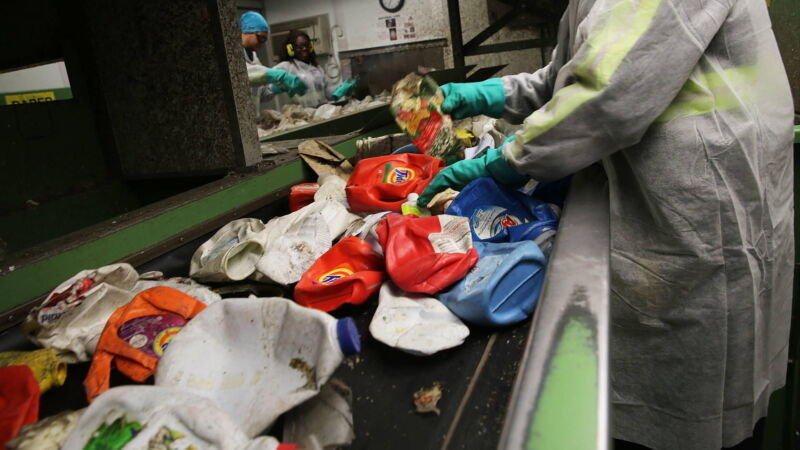To jumpstart a paltry market for recycled plastic, governments across the globe are pushing companies to include recycled materials in their products. Last year, the United Kingdom introduced a tax on manufacturers that produce or import plastic packaging containing less than 30 percent recycled plastic. In 2024, New Jersey will begin enforcing similar rules, albeit with lower targets. California now requires that beverage containers be made of 15 percent recycled materials, and Washington will enact a similar requirement later this year. The European Commission, Canada, and Mexico are all considering comparable moves.
Currently, most plastic products are derived from freshly extracted fossil fuels, including crude oil and natural gas. Incorporating some recycled plastic could reduce emissions, and shrink pollution in waterways and landfills, experts say. But collecting, sorting, pulverizing, and melting post-consumer plastics for reuse is expensive. The new laws will potentially help recyclers find buyers for what would otherwise become waste.
But regulators may need a better way to verify that the new laws are working. While companies can enlist a third-party to certify their use of recycled content, most certifiers take a bird’s-eye view, tracking the materials across a range of products and factories. As a result, an item with a “recycled content” label might be completely devoid of recycled content.
This current approach, called mass balance, poses additional challenges for those seeking to verify recycled content. To work well, mass balance requires trustworthy and accurate data, which are not always available across a convoluted supply chain. Experts warn mass balance may also lead to inflated estimates of recycled content.
Researchers in the UK have developed a novel methodto measure this recycled content that adds fluorescent dyes to recycled plastics at the beginning of manufacturing. By measuring the change in colour, the team can determine the amount of recycled content in each individual plastic product. Through the nonprofit ReCon2, the team is running pilot tests in real-world conditions and says this approach can help prevent fraud, keep costs low, and improve consumer trust.
In 2019, the world generated roughly 350 million tons of plastic, a doubling of production over the past two decades. Just 6 percent of global plastics produced came from recycled plastics, leaving most to be shoveled into landfills, incinerated, or carried into ecosystems. Recycling is not sufficient for solving the problem of plastic pollution, many researchers suggest. Instead, the issue will require some measure of reduction and re-use as well. Nevertheless, scientists say that these new laws and technologies that focus on this last option could mitigate the environmental harms of plastic production.
It's “imperative” to be able to track materials through this recycling market in a way that makes sense, said Katrina Knauer, a researcher at the National Renewable Energy Laboratory. “If we really want to make the circular economy a reality, efficient tracking and quantifiable tracking is going to be the only way we can really do that and create trust in a system.”
Companies like Unilever, Coca-Cola, and PepsiCo have been making claims about using recycled content in their products for years. But the term “recycled content” is as flexible as the term “organic” before regulators clamped down on its use, said Knauer. Earning that badge now requires ticking several boxes determined by federal agencies in the US and the European Commission in the EU. Recycled content hasn’t received the same kind of regulatory scrutiny.
As the recycling industry develops, “I think we will run into some of the same challenges that we ran into in the past with companies making claims that may not be very true,” said Knauer, who is also the chief technology officer at the Bio-Optimized Technologies to keep Thermoplastics out of Landfills and the Environment, an organization at the Department of Energy that helps companies adopt greener plastics technologies.
Right now, many companies use mass balance, which considers all of the inputs that go into making a product and then balances them with the outputs to calculate the amount of recycled material.



3175x175(CURRENT).thumb.jpg.b05acc060982b36f5891ba728e6d953c.jpg)
Recommended Comments
There are no comments to display.
Join the conversation
You can post now and register later. If you have an account, sign in now to post with your account.
Note: Your post will require moderator approval before it will be visible.